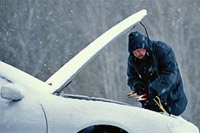This news item expired on Saturday, February 28, 2015 so the information below could be outdated or incorrect.
There are few things more frustrating than getting into a cold vehicle on a frigid morning, turning the key and having nothing happen. Cold temperatures can negatively affect the battery, fuel, oil, belts, and hoses,  making it difficult to start your engine. By taking some of the precautions below, you will have a better chance of starting your vehicle and keeping it running this winter.
making it difficult to start your engine. By taking some of the precautions below, you will have a better chance of starting your vehicle and keeping it running this winter.
- Test the battery. Take the battery to a local auto parts store or use a simple at-home battery tester to make sure it’s fully charged. If the charge is low, hook the battery up to a charger. The average lifespan of a battery is 3-5 years. If your battery shows ‘weak’ and it’s in the 3-5 year age range, it’s probably time to replace it.
- Check the battery cables. These should be attached to your battery tightly, ensuring a strong connection to the engine.
- Clean the battery posts and clamps. Corrosion can keep your battery from making a good connection. A simple mixture of baking soda and water applied with an old toothbrush can clean this off easily. Be sure to dry off the posts and clamps and retighten them when done.
- Use an engine block heater. In extremely low temperatures, this simple electric device heats the engine block to keep the battery, oil, and other components at a reasonable temperature. This helps the engine start more quickly.
- Check the belts and hoses for cracks and wear. Cold weather can make these parts more brittle, causing them to break more easily.
- Fill up the gas tank. This can keep fuel from freezing, and it helps prevent the vapor from condensing or turning into crystals. Keeping the tank at least half full during extreme cold is a good rule of thumb.
- Test your antifreeze. Even if you have antifreeze in your engine, it may be at the end of its life cycle or you may not have the right water/coolant (50/50) mix to protect against the cold. Antifreeze/coolants come in a variety of colors and chemistries these days. If you need to top off or replace your antifreeze/coolant, check your owner’s manual for the recommended antifreeze type.
- Use a fuel additive like Heet to prevent freeze-ups in fuel lines. This helps eliminate water in the fuel lines, but if your fuel line is already frozen, it won’t help. Fuel line antifreeze also increases the evaporation rates of cold gasoline, which can affect how well the engine fires.
- Turn off the radio, heat, and lights before starting the engine. These extra functions sap power from the battery, which is already weakened by the cold weather.
- Spray the door locks with WD-40. To drive your car, you have to be able to get inside. Spraying the locks with WD-40 or graphite can help prevent them from freezing up overnight. You can also lube the door’s gaskets with silicone or WD-40 to keep the door from freezing to the jamb. A standard deicer is a good thing to keep handy if you forget to do this beforehand.
Source: www.oreillyauto.com